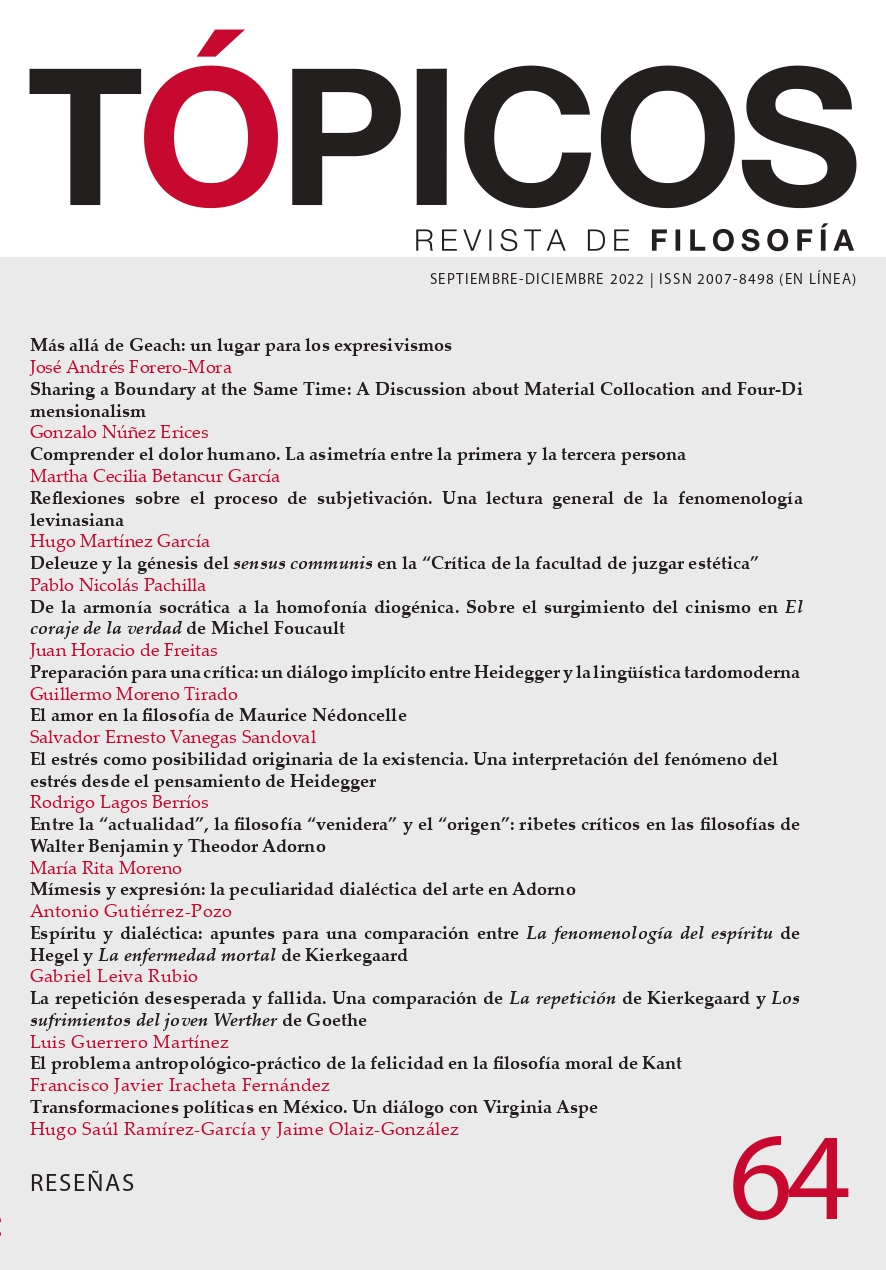Mimesis and Expression: The Dialectical Peculiarity of Art in Adorno
Pubblicato 2022-08-13
Parole chiave
Come citare
Copyright (c) 2022 Tópicos, Revista de Filosofía

Questo lavoro è fornito con la licenza Creative Commons Attribuzione - Non commerciale - Non opere derivate 4.0 Internazionale.
Downloads
Altmetrics
Citas
Abstract
The aim of this article is to show that, according to Theodor Adorno, art is knowledge, it has gnoseological relevance, and is linked to truth. While Adorno makes a radical separation and distinction between art and philosophy, at the same time he claims that they have a complementary and collaborative relationship. This relationship can only be grounded on the understanding of art as dialectics and estrangement from the real world. The dialectical link with concrete reality grounds two aesthetic concepts that characterize the peculiar way of thinking in art, namely, “mimesis” and “expression.” After dealing with the mimetic-expressive condition of art, the article clarifies the complementary relationship between art and philosophy.
Riferimenti bibliografici
- Adorno, T. ([1931] 1979). Kierkegaard. Konstruktion des Ästhetischen. Gesammelte Schriften. 2. Suhrkamp.
- Adorno, T. ([1947] 1984). Dialektik der Aufklärung. Gesammelte Schriften. 3. Suhrkamp.
- Adorno, T. ([1958-1959] 2009). Ästhetik (1958-59). Nachgelassene Schriften. Abteilung IV: Vorlesungen. Band 3. Suhrkamp.
- Adorno, T. ([1962-1964a] 1997). Philosophische Terminologie. Zur Einleitung. I. Suhrkamp.
- Adorno, T. ([1962-1964b] 1997). Philosophische Terminologie. Zur Einleitung. II. Suhrkamp.
- Adorno, T. ([1966] 1977). Negative Dialektik. Gesammelte Schriften. 6. Suhrkamp.
- Adorno, T. ([1969] 1984). Ästhetische Theorie. Gesammelte Schriften. 7. Suhrkamp.
- Brunkhorst, H. (2017). Die Dialektik der Aufklärung nach siebzig Jahren. En G. Hindrichs (ed.), M. Horkheimer / Theodor W. Adorno: Dialektik der Aufklärung. (pp. 179-197). De Gruyter.
- Di Cesare, D. (2009). Gadamer – Ein philosophisches Porträt. Mohr Siebeck.
- Gadamer, H.-G. ([1967] 1993). Kunst und Nachahmung. En Gesammelte Werke. Band 8. Ästhetik und Poetik. I. Kunst als Aussage. (pp. 25-36). Mohr Siebeck.
- Gadamer, H.-G. ([1972] 1993). Dichtung und Mimesis. En Gesammelte Werke. Band 8. Ästhetik und Poetik I. Kunst als Aussage. (pp. 80-85). Mohr Siebeck.
- Gandesha, S. (2004). Leaving Home. On Adorno and Heidegger. En T. Huhn (ed.), The Cambridge Companion to Adorno. (pp. 101-128). Cambridge University Press.
- Geulen, E. (2004). Adorno’s Aesthetic Theory. En T. Huhn (ed.), The Cambridge Companion to Adorno. (pp. 397-411). Cambridge University Press.
- Hegel, G. W. F. ([1817-1831] 1986). Enzyklopädie der philosophischen Wissenschaften. I. Werke. 8. Suhrkamp.
- Hegel, G. W. F. ([1818-1829] 1986). Vorlesungen über die Ästhetik. I. Werke. 13. Suhrkamp.
- Heidegger, M. ([1935] 1977). Der Ursprung des Kunstwerkes. En Gesamtausgabe. I. Abteilung: Veröffentlichte Schriften 1910–1976. Band 5. Holzwege. (pp. 1-74). Vittorio Klostermann.
- Hegel, G. W. F. ([1938] 1977). Die Zeit des Weltbildes. En Gesamtausgabe. I. Abteilung: Veröffentlichte Schriften 1910–1976. Band 5. Holzwege. (pp. 75-113). Vittorio Klostermann.
- Hegel, G. W. F. ([1943] 1977). Nietzsches Wort Gott ist tot. En Gesamtausgabe. I. Abteilung: Veröffentlichte Schriften 1910–1976. Band 5. Holzwege. (pp. 209-267). Vittorio Klostermann.
- Hegel, G. W. F. ([1947] 1983). Aus der Erfahrung des Denkens. En Gesamtausgabe. I. Abteilung: Veröffentlichte Schriften 1910–1976. Band 13. Aus der Erfahrung des Denkens (1910-1976). (pp. 75-86). Vittorio Klostermann.
- Hegel, G. W. F. ([1953] 2000). Die Frage nach der Technik. En Gesamtausgabe. I. Abteilung: Veröffentlichte Schriften 1910–1976. Band 7. Vorträge und Aufsätze. (pp. 5-36). Vittorio Klostermann.
- Huhn, T. (2004). Introduction. Thoughts beside Themselves. En T. Huhn (ed.), The Cambridge Companion to Adorno. (pp. 1-18). Cambridge University Press.
- Kant, I. ([1790] 1990). Kritik der Urteilskraft. Felix Meiner.
- Knatz, L. (1998). Die Philosophie der Kunst. En H. J. Sandkühler (ed.), F. W. J. Schelling. (pp. 109-123). J. B. Metzler.
- Lear, G. R. (2006). Plato on Learning to Love Beauty. En G. Santas (ed.), The Blackwell Guides to Plato’s Republic. (pp. 104-125). Blackwell.
- Platón. (1938). Œuvres complètes. Tome IV, 2e partie. Le banquet (Συηπόσιον).Les Belles Lettres.
- Sallis, J. (2007). The Hermeneutics of the Artwork (GW 1, 87-138). En G. Figal (ed.), H.-G. Gadamer: Wahrheit und Methode. (pp. 45-58). Akademie Verlag.
- Schelling, F. W. J. ([1800] 2005). System des transzendentalen Idealismus. Werke. Band 9-1. Frommann-Holzboog.
- Schneider, W. (1983). Ästhetische Ontologie. Schellings Weg des Denken zur Identitätsphilosophie. Peter Lang.
- Sherratt, Y. (2002). Adorno’s Positive Dialectic. Cambridge University Press.
- Silberbusch, O. C. (2018). Adorno’s Philosophy of the Nonidentical. Thinking as Resistance. Palgrave Macmillan.
- Spencer, H. ([1855] 1966). The Works of Herbert Spencer. The Principles of Psychology. II. Otto Zeller.
- Vattimo, G. (1985). Poesia e ontologia. Mursia.





